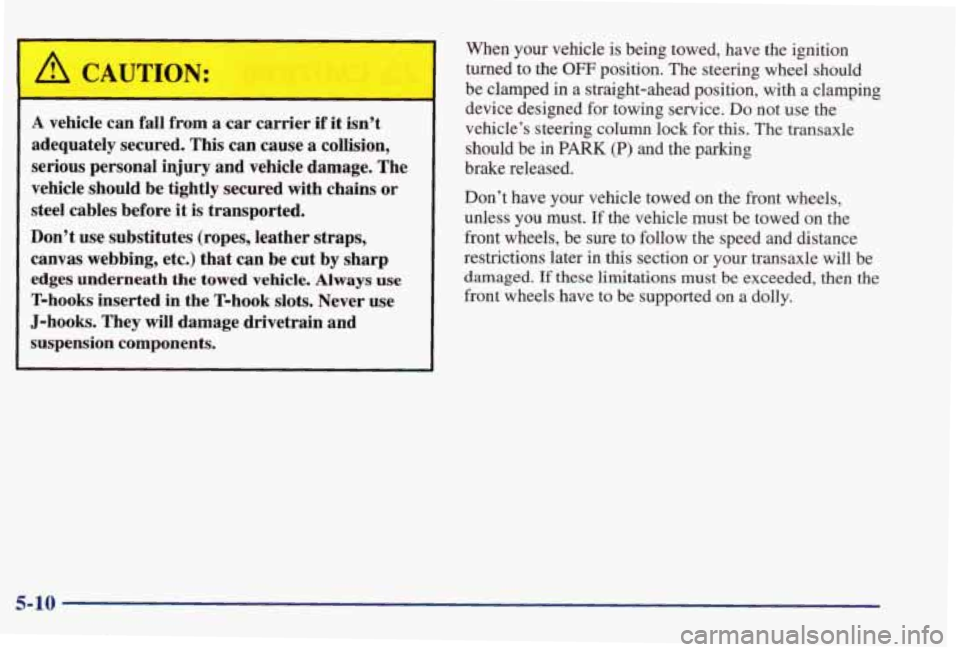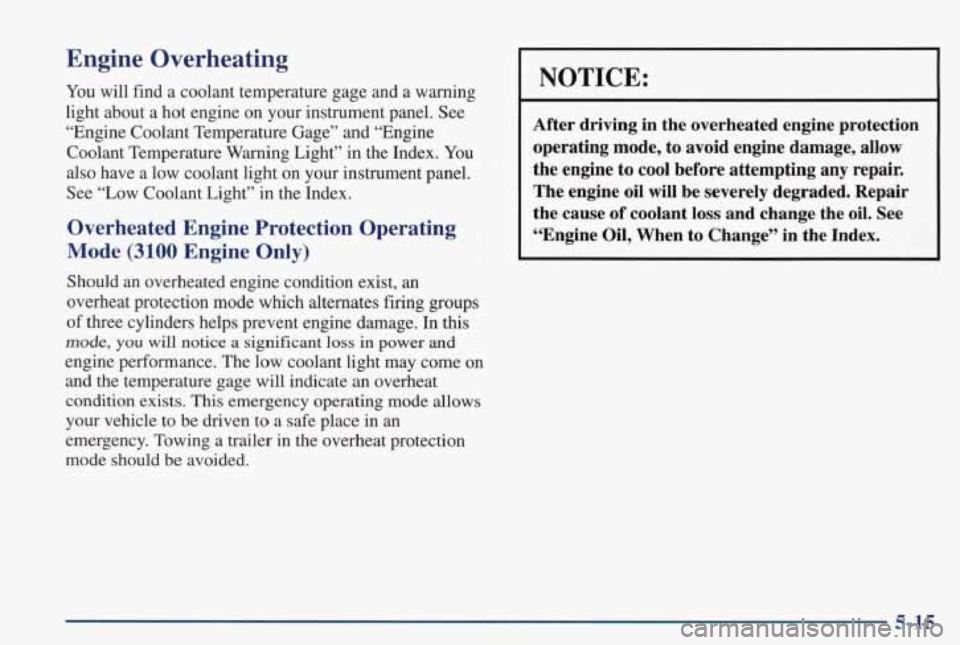Page 243 of 402
12. Remove the cables in reverse order to prevent
electrical shorting. Take care that they don’t touch
each
other or any other metal.
nlo I
A. Heavy Metal Engine Part
B. Good Battery
C. Dead Battery
Towing Your Vehicle
Try to have a GM dealer or a professional towing
service tow your vehicle.
See “Roadside Assistance” in
the Index.
If your vehicle has been changed or modified since it
was factory-new by adding aftermarket items like fog
lamps, aero skirting,
or special tires and wheels, these
instructions and illustrations may not be correct.
Before you do anything, turn on the hazard
warning flashers.
When you call, tell the towing service:
0 That your vehicle cannot be towed from the front
0 That your vehicle has front-wheel drive.
The make, model and year of your vehicle.
0 Whether you can still move the shift lever.
0 If there was an accident, what was damaged.
with sling-type equipment.
5-8
Page 244 of 402
When the towing service arrives, let the tow operator
know that this manual contains detailed towing
instructions and illustrations. The operator may want to see them. A CAUTION:
To help avoid injury to you or others:
Never let passengers ride in a vehicle that is
Never tow faster than safe or posted speeds.
Never tow with damaged parts not
fully secured.
Never get under your vehicle after it has
been lifted
by the tow truck.
Always secure the vehicle on each side with
separate safety chains when towing
it.
Never use J-hooks. Use T-hooks instead. being towed.
5-9
Page 245 of 402

A CAUTION:
A vehicle can fall from a car carrier if it isn’t
adequately secured. This can cause a collision,
serious personal injury and vehicle damage. The
vehicle should be tightly secured with chains
or
steel cables before it is transported.
Don’t use substitutes (ropes, leather straps,
canvas webbing, etc.) that can be cut by sharp
edges underneath
the towed vehicle. Always use
T-hooks inserted in the T-hook slots. Never use
J-hooks. They will damage drivetrain and
suspension components.
When your vehicle is being towed, have the ignition
turned
to the OFF position. The steering wheel should
be clamped
in a straight-ahead position, with a clamping
device designed for towing service.
Do not use the
vehicle’s steering column lock for this. The transaxle
should be
in PARK (P) and the parking
brake released.
Don’t have
your vehicle towed on the front wheels,
unless you must. If the vehicle must be towed on the
front wheels, be sure to follow the speed and distance
restrictions later
in this section or your transaxle will be
damaged. If these limitations must be exceeded, then the
front wheels have to be supported on a dolly.
5-10
Page 246 of 402
Front Towing -1 These slots are to be used
I NOTICE:
When attaching T-hooks to the shipping slots in
the frame rail, attach them inside of the frame to
avoid damage to the frame
or front fascia.
5-11
Page 247 of 402
I NOTICE:
Do not tow with sling-type equipment or
fascidfog lamp damage will occur. Use wheel-lift
or carcarrier equipment. Additional ramping
may be required for carcarrier equipment. Use
safety chains and wheel straps.
Towing a vehicle over rough surfaces could
damage a vehicle. Damage can occur from vehicle
to
ground or vehicle to wheel-lift equipment. To
help avoid damage, raise the vehicle until
adequate clearance is obtained between the
ground and/or wheel-lift equipment.
Do not attach winch cables or J-hooks to
suspension components when using carcarrier
equipment. Always use
T-hooks inserted in the
T-hook slots. Attach a separate safety chain around
the outboard end of each lower control arm.
NOTICE:
I
Take care not to damage speed sensor wires or
brake hoses when attaching chains and T-hooks.
5-12
Page 248 of 402
Rear Towing
Tow Limits -- 35 mph (55 k&), 500 miles (800 km)
Use wheel-lift or car-carrier equipment. Additional
ramping may
be required for car-carrier equipment.
Use safety chains and wheel straps. For rear towing,
the parking brakes must be applied.
I NOTICE:
If the vehicle must be towed on the front wheels,
it cannot be towed more than a total of 500 miles
(800 km) for the lifetime of the vehicle.
NOTICE:
Do not tow with sling-type equipment or the rear
bumper fascia will be damaged.
Towing a vehicle over rough surfaces could
damage
a vehicle. Damage can occur from
vehicle
to ground or vehicle to wheel-lift
equipment. To help avoid damage, install
a
towing dolly and raise the vehicle until adequate
clearance
is obtained between the ground and/or
wheel-lift equipment.
Do not attach winch cables or J-hooks to
suspension components when using carcarrier
equipment. Always use T-hooks inserted in
the T-hook slots.
5-13
Page 250 of 402

Engine Overheating
You will find a coolant temperature gage and a warning
light about a hot engine on your instrument panel. See
“Engine Coolant Temperature Gage” and “Engine
Coolant Temperature Warning Light” in the Index. You
also have a low coolant light on your instrument panel.
See “Low Coolant Light” in the Index.
Overheated Engine Protection Operating
Mode
(3100 Engine Only)
Should an overheated engine condition exist, an
overheat protection mode which alternates firing groups
of three cylinders helps prevent engine damage. In this
mode, you will notice a significant loss in power and
engine performance. The low coolant light may come on
and the temperature gage will indicate an overheat
condition exists. This emergency operating mode allows
your vehicle to be driven to a safe place in an
emergency. Towing a trailer in the overheat protection
mode should
be avoided.
NOTICE:
After driving in the overheated engine protection
operating mode, to avoid engine damage,
allow
the engine to cool before attempting any repair.
The engine
oil will be severely degraded. Repair
the cause of coolant loss and change the oil. See
“Engine Oil, When to Change” in the Index.
5-15
Page 274 of 402
Rocking Your Vehicle To Get It Out
clear the area around your front wheels. Then shift back
NOTICE:
I First, turn your steering wheel left and right. That will
Spinning your wheels can destroy parts of your
shift lever is in FIRST (1) or SECOND (2) gear. Release forth, you can destroy your transaxle.
The enhanced traction system will turn off when the too fast while shifting your transaxle back and
SECOND (2), spinning the wheels as little as possible. vehicle as well as the tires. If you spin the wheels
and forth between REVERSE (R) and FIRST (1) or
the accelerator pedal while you shift, and press lightly
on the accelerator pedal when the transaxle
is in gear. If
For information about using tire chains on your vehicle, that doesn’t get you out after a few tries, you may need
see
“Tire Chains” in the Index. to be towed out. If you do need to be towed out, see
“Towing Your Vehicle” in the Index.